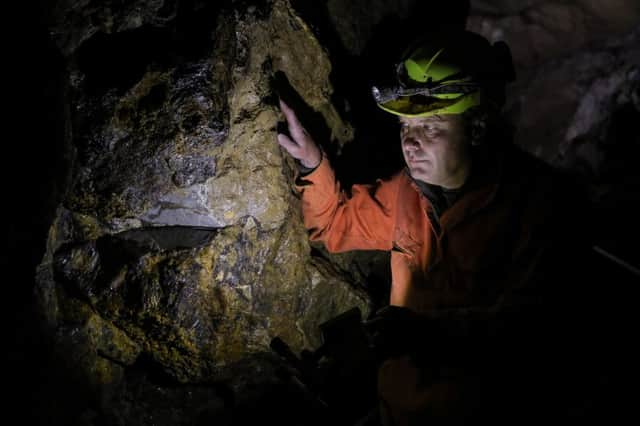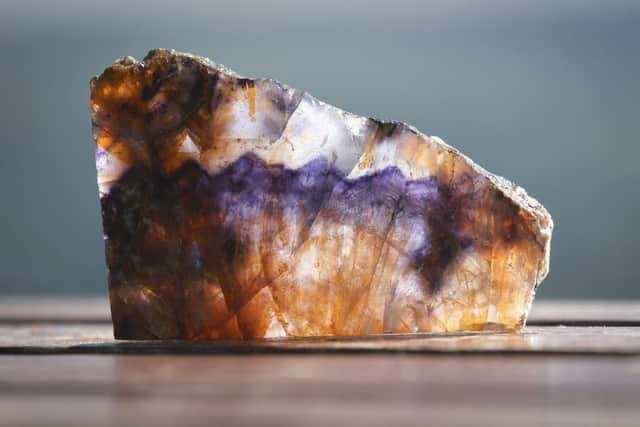‘A new chapter’ in the story of Blue John stone


But in more than 150 years, not a single new vein of the distinctive stone has been discovered - until now.
The stone is found in just one place, beneath Treak Cliff Hill, nestled in the Hope Valley near the village of Castleton.
Advertisement
Hide AdAdvertisement
Hide AdEach vein has its own characteristic colour and banding of blue, purple, yellow and white; and historically there have been just 14 distinctive identified veins.


The last was discovered in the mid 1800s, until miner Gary Ridley uncovered the vein - dubbed a “major new development” in the history of Blue John Stone.
Mr Ridley, the mine manager at Treak Cliff Cavern, which is the only place still actively mining Blue John Stone, was trying a new method of mining using a stone chainsaw when he made the discovery.
He said: “I decided to try the new saw in an area of the cavern we’ve never dug in before. It is just off the tourist route and as the traditional method of mining using ‘plug and feather’ is noisy we wouldn’t normally dig there.
Advertisement
Hide AdAdvertisement
Hide Ad“However having spotted a small amount of crystallization near the handrail it was just an easy and convenient place to see how well the saw would cut as it was close to the source of water for the saw and I could stand on the concrete path whilst sawing.
“I couldn’t believe my eyes when within a few minutes I had uncovered a substantial deposit of Blue John unlike any other vein I had ever seen before.”
The vein, which has swirling patterns of purple and blue, has been named the Ridley Vein after the miner who found it.
Blue John expert and senior lecturer in geology at Leicester University, Dr Trevor Ford said: “This is a major new development in the history of Blue John stone. Some of the earliest recorded names for Blue John veins go back as far as the 18th century and by Victorian times the 14 names were fairly well established.
Advertisement
Hide AdAdvertisement
Hide Ad“Other veins discovered in the intervening years have been sub-varieties of the 14 named veins, until now. The Ridley Vein is substantially different and enters the history books as variant number 15, the first new variety of Blue John to be discovered in over 150 years.”
The discovery of the Ridley Vein is the second major find in Treak Cliff Cavern in recent years. In 2013 the ‘lost vein’ was uncovered. It had lain hidden for over 70 years when the original miner who found it, John Royse, died before he could reveal the exact location to new mine owner Peter Harrison. It was found 70 years later by Peter’s grandson John Turner, hidden under an old carpet and covered in clay.
Stone craftsman from the Cavern have already started working the stone from the Ridley Vein into decorative bowls and other pieces, which Vicky Turner, whose family have owned and managed Treak Cliff Cavern since the 1940s, said will be of “great interest” to collectors.
She said: “We have made some amazing discoveries in Treak Cliff Cavern over the years, including uncovering of the lost vein in 2013, but the discovery of the Ridley Vein is a major new chapter in the story of Blue John Stone. It seems fitting to name the new vein after the man who discovered it, Gary Ridley.”
Advertisement
Hide AdAdvertisement
Hide AdIT IS a reaction between the flurospar that makes up much of Blue John with other chemicals that gives the stone it distinctive banded streaks.
The mineral was formed millions of years ago, although only a small quantity is allowed to be mined each year.
Treak Cliff Cavern has been designated as a Site of Special Scientific Interest and is a show cave featuring spectacular formations of stalactites and flowstone.
The origin of the name Blue John is thought to have come from the French ‘bleu et jaune’, meaning blue and yellow. It was particularly fashionable in the Regency era.